- Blog
- EKS Optimization
- Datadog Container Rightsizing Alternatives: The Essential Guide
Datadog Container Rightsizing Alternatives: The Essential Guide
Kubernetes has made deploying and scaling applications straightforward, but keeping container resources optimized is still a challenge. Over-provisioned CPU and memory waste money, while under-provisioning can hurt performance.
Container rightsizing tools aim to strike the right balance, yet approach, accuracy, and cost-effectiveness can vary widely. This comparison looks at how Datadog’s Kubernetes Agent handles container rightsizing versus alternatives, highlighting the differences and how to find the best fit for your workloads.
Datadog Container Rightsizing with Datadog Kubernetes Agent
Datadog’s Kubernetes Agent (DKA) offers scaling features designed to adjust workloads based on observed resource usage. While these features are tightly integrated into the Datadog monitoring ecosystem, the way they work—and the data they rely on—has a major impact on optimization results.
Vertical scaling (adjusting CPU/memory limits per container)
Datadog Kubernetes Agent can automatically recommend or apply changes to CPU and memory requests and limits for individual containers. This helps reclaim unused capacity from workloads that are over-provisioned, while giving more resources to workloads that frequently run out of CPU or memory. Vertical scaling is aimed at reducing waste without changing the number of running workloads.
Horizontal scaling (adjusting the number of replicas)
In addition to vertical scaling, Datadog can adjust the replica count for a given deployment. By increasing replicas during high demand and reducing them during lulls, teams can better match workload capacity to real-time demand. This scaling operates at the deployment level and can help smooth performance during traffic spikes or scale back to save resources during idle periods.
Multi-dimensional scaling
Datadog Kubernetes Agent combines vertical and horizontal scaling under what it calls “multi-dimensional scaling.” This allows teams to simultaneously tune per-container resources and overall workload replication, potentially improving efficiency and responsiveness. This approach uses sustained utilization thresholds to determine when to resize or replicate workloads. For a greater discussion of multidimensional scaling, check out our recent episode of nCast.
Limitations of Datadog Kubernetes Agent's Approach
While Datadog’s integration and ease of use are appealing for existing customers, there are notable trade-offs in cost, accuracy, and reporting depth.
- High costs. Datadog’s container rightsizing depends on the same Kubernetes usage metrics it collects for monitoring. The problem is that collecting and storing those metrics in Datadog is expensive—especially in large clusters with high metric cardinality. Even before you act on rightsizing recommendations, the cost of simply getting the data you need can be substantial.
- Limited visibility into realized cost savings. Even if scaling actions result in lower cloud bills, Datadog doesn’t provide reporting that quantifies the savings achieved. Without that visibility, teams lack the data to justify optimization work or prove results to stakeholders.
- Lacks benchmarking to compare performance and efficiency over time. Datadog doesn’t include built-in benchmarking to compare workloads before and after scaling. This makes it harder to evaluate whether changes improved efficiency or simply shifted resource usage patterns without measurable benefit.
- No integration with AWS cost data. Datadog’s recommendations are based solely on resource utilization metrics, without correlating them to AWS cost data. This means it can’t make optimal decisions on when to rightsize—such as targeting workloads that are underutilizing Savings Plans or Reserved Instances — leading to changes that save resources but aren’t more cost-effective.
nOps Container Rightsizing
nOps Container Rightsizing is built to automatically optimize your Kubernetes workloads for cost, performance, and reliability. As clusters scale, managing CPU and memory requests manually can lead to chronic over-provisioning, wasted spend, or performance risk from under-provisioning. nOps solves this by continuously analyzing your workloads’ real resource usage and automatically adjusting requests so you only pay for the capacity you actually need.
Optimized Recommendations at Four Levels
nOps evaluates the last 30 days of real-world CPU and memory consumption for each workload, generating recommendations at four service levels:
- Maximum savings – most aggressive for cost reduction.
- Dynamic – performance-focused while still seeking savings.
- High Availability – maximum headroom for critical workloads.
These recommendations are statistically modeled from production usage patterns, and by default, nOps selects the most appropriate level automatically.
Multi-Dimensional Autoscaling
nOps supports both vertical scaling and horizontal scaling, and can apply them in combination for multi-dimensional autoscaling. This allows workloads to scale in two directions simultaneously—optimizing per-container resource requests while also adjusting your HPA if you have HPA in place. Ultimately leading to the decreased number of running instances—ensuring efficiency during low load and reliability during traffic spikes.
Automatic Optimization with nOps VPA
Using a custom Vertical Pod Autoscaler, nOps can apply new rightsizing recommendations automatically as workloads change—without manual edits to manifests or patches. Supported workload types include Deployments, CronJobs, DaemonSets, and StatefulSets. Automatic optimization can be toggled per workload for maximum control.
Full Audit History and Rollback
Every change is logged in a History of Actions dashboard, showing when and why adjustments were made. One-click rollback lets you revert to original configurations instantly, enabling safe experimentation with no risk of being locked into suboptimal settings.
Lightweight Agent
A lightweight nOps agent collects granular usage and cost data from your EKS cluster. This data flows through nOps’ analytics pipelines, which calculate optimal CPU and memory requests for each workload. Recommendations refresh hourly, ensuring workloads remain tuned to current conditions. When paired with the nOps Pod Autoscaler, this creates a hands-off optimization loop that keeps workloads stable, performant, and cost-efficient at all times.
Datadog vs nOps: When To Choose Each
Choosing between Datadog and nOps for container rightsizing depends on your existing tooling, budget, and how important cost attribution and automation are to your workflows.
Datadog: Best if you are already heavily invested in the Datadog monitoring ecosystem and want basic rightsizing capabilities that work within your existing dashboards and workflows, and you’re comfortable with the high monitoring bill.
nOps: Best if you need rightsizing driven by actual cost data, multi-dimensional autoscaling, automated optimization, benchmarking, and detailed reporting—without the high additional costs of metric collection. nOps is a true FinOps tool specialized in EKS optimization that allows you to pay only for what you use with flat, predictable pricing.

More About nOps
The complete nOps EKS Visibility & Optimization feature set includes:
- Kubernetes Cost allocation: Allocate 100% of your AWS bill down to the container level with automated tagging, showbacks, chargebacks
- Total EKS Visibility: See cost, usage, and efficiency data across nodes and containers—plus pricing insights—all in one powerful Kubernetes UI
- Full Stack Reporting: Dashboards, reports, budgets, forecasting, and anomaly detection for visibility into 100% of your Multicloud, K8s, SaaS & AI spend
- EKS Optimization: continuously manage, scale, and optimize at the node, pod and pricing level
Hop on a call to find out how to get 100% accurate Kubernetes cost allocation set up in minutes.
nOps was recently ranked #1 with five stars in G2’s cloud cost management category, and we optimize $2 billion in cloud spend for our customers.





